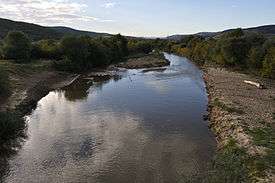Târnava Mare
The Târnava Mare ("Great Târnava"; Hungarian: Nagy-Küküllő; German: Große Kokel) is a river in Romania.[1][2] Its total length is 223 km (139 mi) and its basin size is 3,666 km2 (1,415 sq mi).[2][3] Its source is in the Eastern Carpathian Mountains, near the sources of the Mureș and Olt in Harghita County. It flows through the Romanian counties of Harghita, Mureș, Sibiu, and Alba. The cities of Odorheiu Secuiesc, Sighișoara, and Mediaș lie on the Târnava Mare. It joins the Târnava Mică in Blaj, forming the Târnava.
| Târnava Mare Nagy-Küküllő, Große Kokel | |
|---|---|
 The Târnava Mare near Blaj | |
| Location | |
| Country | Romania |
| Counties | Harghita, Mureș, Sibiu, Alba |
| Towns | Odorheiu Secuiesc, Sighișoara, Mediaș, Blaj |
| Physical characteristics | |
| Source | Gurghiu Mountains |
| • elevation | 1,455 m (4,774 ft) |
| Mouth | Târnava |
• location | Blaj |
• coordinates | 46°10′16″N 23°53′31″E |
| Length | 223 km (139 mi) |
| Basin size | 3,666 km2 (1,415 sq mi) |
| Discharge | |
| • location | * |
| • average | 14.5 m3/s (510 cu ft/s) |
| Basin features | |
| Progression | Târnava→ Mureș→ Tisza→ Danube→ Black Sea |
| Tributaries | |
| • left | Șaeș, Vișa |
| • right | Feernic |
Towns and villages
The following towns and villages are situated along the river Târnava Mare, from source to mouth: Subcetate, Zetea, Brădești, Odorheiu Secuiesc, Feliceni, Mugeni, Porumbeni, Cristuru Secuiesc, Secuieni, Sighișoara, Daneș, Dumbrăveni, Dârlos, Mediaș, Copșa Mică, Micăsasa, Valea Lungă, Blaj.
Tributaries
The following rivers are tributaries to the river Târnava Mare (from source to mouth):[2]
Left: Chiuveș, Vărșag, Șicasău, Pârâul Băutor, Deșag, Brădești, Gorom, Hodoș, Mugeni, Pârâul Caprelor, Scroafa, Pârâul Cărbunarilor, Daia, Șapartoc, Valea Dracului, Vâlcăndorf, Șaeș, Criș, Laslea, Valchid, Biertan, Ațel, Valea Mare, Buzd, Moșna, Ighiș, Vorumloc, Vișa, Șeica, Soroștin, Cenade, Spătac, Veza
Right: Tartod, Creanga Mică, Pârâul Rece, Senced, Busniac, Pârâul Sărat, Cireșeni, Beta, Tăietura, Fâneața Îngustă, Feernic, Goagiu, Eliseni, Rogoz, Valea Morii, Prod, Fântâna Veteului, Giacăș, Șmig, Curciu, Păucea, Chesler, Valea Lungă
Târnava Mare SCI
The dry grassland habitat beside the river is now part of a (SCI) Site of Community Importance.[4]
References
- "Planul național de management. Sinteza planurilor de management la nivel de bazine/spații hidrografice, anexa 7.1" (PDF, 5.1 MB). Administrația Națională Apele Române. 2010. pp. 337–340.
- Atlasul cadastrului apelor din România. Partea 1 (in Romanian). Bucharest: Ministerul Mediului. 1992. pp. 156–164. OCLC 895459847. River code: IV.1.96
- 2017 Romanian Statistical Yearbook, p. 13
- Šeffer, Jan (15 December 2013). "CONSERVATION ACTION PLAN" (PDF). fundatia-adept.org. Retrieved 29 August 2015.
External links
| Wikimedia Commons has media related to Târnava Mare. |